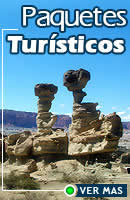 Tourist Destinations City of Buenos Aires (In Spanish)
Tourist Destinations City of Buenos Aires (In Spanish) By Regions
By RegionsSan Telmo, City of Buenos Aires
San Telmo, Buenos Aires City, Hotels and Tours, Argentina
As a Colonial postcard of the City of Buenos Aires, San Telmo leads the tourist through cobbled streets that bend around corners without chamfer, where we find old adobe and brick houses. It is one of the most characteristic neighborhoods of the City of Buenos Aires, land of candombes and tangos, which used to be part of "Barrio Sur" togheter with Montserrat.
San Telmo is described as an almost motionless piece on the changing scenario of Buenos Aires. There is where the past looks like present as we can observe in building structures, cobblestones and even in the Afro-River Plate rhythm that still echoes everywhere.

San Lorenzo Passage and its typical XVIII century mansion; La Defensa Passage and the exceptional antiquarian; the strange Casa Mínima with a front of 2.2 m; the Viejo Hotel transformed into an art gallery; the Mercado de San Telmo, a fascinating iron structure with sheet and glass roofs opened in 1897, Plaza Dorrego declared a National Historic Site and stage of a colorful Antique Fair every Sunday afternoon, are part of San Telmo historical and cultural circuit.
Among other buildings, homes of Argentine personalities, monuments and religious temples, is the Museo Penitenciario Argentino and its long history that began in 1760; the Museo de Arte Moderno, the Museo Histórico Nacional and the Museo del Cine, with its fascinating collection of films, posters, costumes, photos and documents.

The traditional Bar Británico and Bar Sur, a pioneer in Buenos Aires evening shows, close San Telmo's proposal that, in addition, on Saturdays and Sundays, Defensa becomes a pedestrian street, delivering an enchanting show of street artists, magicians, living statues and puppeteers.
San Telmo is described as an almost motionless piece on the changing scenario of Buenos Aires. There is where the past looks like present as we can observe in building structures, cobblestones and even in the Afro-River Plate rhythm that still echoes everywhere.

Picture - Argentinaturismo.com.ar
San Lorenzo Passage and its typical XVIII century mansion; La Defensa Passage and the exceptional antiquarian; the strange Casa Mínima with a front of 2.2 m; the Viejo Hotel transformed into an art gallery; the Mercado de San Telmo, a fascinating iron structure with sheet and glass roofs opened in 1897, Plaza Dorrego declared a National Historic Site and stage of a colorful Antique Fair every Sunday afternoon, are part of San Telmo historical and cultural circuit.
Among other buildings, homes of Argentine personalities, monuments and religious temples, is the Museo Penitenciario Argentino and its long history that began in 1760; the Museo de Arte Moderno, the Museo Histórico Nacional and the Museo del Cine, with its fascinating collection of films, posters, costumes, photos and documents.

Picture - Argentinaturismo.com.ar
The traditional Bar Británico and Bar Sur, a pioneer in Buenos Aires evening shows, close San Telmo's proposal that, in addition, on Saturdays and Sundays, Defensa becomes a pedestrian street, delivering an enchanting show of street artists, magicians, living statues and puppeteers.




 La Boca
La Boca
